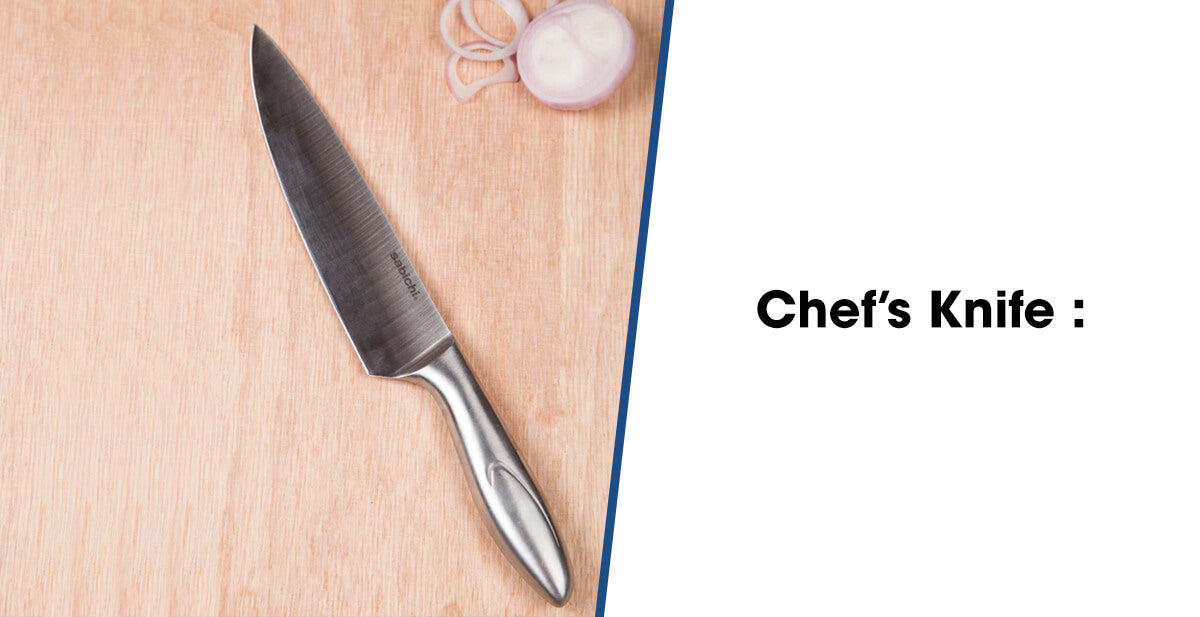Having the right tools is essential for preparing food, but with so many different types of knives to choose from, finding the one that suits your needs is tricky. Without the proper knowledge, it’s too easy to buy a set of kitchen utensils you hardly ever use.
Making matters worse is the naming convention used for naming knives that is extremely confusing. Intending to help you make sense of it all, we’ve compiled a guide to every type of knife and its uses, plus some comments to help you get a grip on what knife to choose for which situation.
Chef’s Knife
Often also referred to as cook’s knife. The chef’s knife is made up of a long, broad blade with a straight edge which is widest across the heel and tapers up to a fine pointed tip.
The blade of a chef’s knife is curved allowing it to be rocked back and forth on the chopping board making it one of those perfect cooking utensils that will help you in chopping and dicing a great number of vegetables at once.
It’s ideal for everyday dicing and chopping of even thicker and harder veggies like potatoes or onions. Being one of the most versatile knives in the kitchen, it is flawless for everyday dicing and mincing tasks.

Bread Knife
A bread knife is designed to be used on softer items with its blade edge mimicking a saw. The long and sharp serrated edge of this knife makes it ideal for carving through bread, including crusty bread, bread rolls and bagels. Because of the grooved edge, it allows you to pierce even softer textured items without changing or crushing their shape.
You can also use bread knives to slice soft and fluffy textured cakes without knocking the air out of the sponge or damaging the shape of the cake. Whereas another use of a Bread Knife can be to level your sponge cakes after baking.

Carving Knife
A long, slim knife that tapers to a point, often also referred to as a slicing knife. It is one of the longest kitchen knives which allows it to cut through food cleanly letting you make uniform slices.
Carving Knife comes in handy when you are serving meats i.e, chicken, mutton or fish. This type of knife allows you to create even-sized clean slices of these meats and can also be utilized to slice large fruits and vegetables like melons.
A rare yet nevertheless used utility of a carving knife is to cut the cake, thanks to its long blade you get to create proper slices of the cake without hampering its texture or shape in one simple cutting motion.
Utility Knife
A utility knife is similar in shape to a chef knife but only thinner and smaller. For chopping smaller veggies and foods like lemon, oranges and cucumber, a utility knife is your best friend.
As a utility knife provides you with precision cutting work. When your chef’s knife is too big for the job, you should reach out for a utility knife.

Paring Knife
A paring knife is a short, slim knife with a pointed tip that is light allowing you to easily manoeuvre your way around delicate work.
You can use this for cutting, chopping and slicing fruits and vegetables while for another kitchen this will be the knife that comes to your head first. Even though they are smaller in size they can be used to cut through harder foods like potatoes meanwhile also allowing you to peel, trim or remove seeds from fruits and veggies alike.


